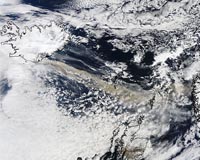 |
Bonn, Germany (SPX) Apr 19, 2010 The Icelandic volcano Eyjafjallajokull has ejected large quantities of ash and sulphur dioxide into the atmosphere during its eruptions on 21 March and 15 April. Scientists from the German Aerospace Center are evaluating satellite images to investigate the effects of the eruptions on the atmosphere. "Volcanoes are 'global air polluters'. Gases and ash particles are frequently catapulted up to 15 kilometres into the atmosphere or higher. They are then transported by large-scale air currents, often over many thousands of kilometres," report atmosphere researchers Dr Michael Bittner of the German Remote Sensing Data Center and Dr Hans Volkert of the DLR Institute of Atmospheric Physics in Oberpfaffenhofen. With his team, Dr Bittner derives information from measurements performed by Earth observation satellites, such as the European MetOp-A and the American NOAA 19, which shed light on the shape and course of the gigantic ash cloud southeast of Iceland. For example, the instrument GOME-2 (Global Ozone Monitoring Experiment) on MetOp-A allows the observation of ozone in the atmosphere.
Satellite instruments reveal invisible gases Sulphur dioxide, for example, can remain in the atmosphere for a very long time. If it rises through higher layers of the atmosphere and into the stratosphere, this can damage the ozone layer. "Volcanic eruptions have not only regional, but also continental or even global effects on the atmosphere. Ash particles do not only affect the safety of air traffic or the health of humans, they can also change the amount of solar radiation that reaches the ground," continue Drs Bittner and Volkert. Particularly fine soot particles could remain in the atmosphere for months and affect the temperature distribution. In addition, these soot particles can serve as condensation nuclei for cloud formation and thus likewise exert influence on the radiation balance. "The satellite data provide little information on the eruption of the volcano," clarifies Dr Volkert. "However, the images give us crucial information about the direction and speed at which the ash cloud is spreading," he adds. It is still too early for an accurate assessment of the consequences of the Icelandic eruption. "In general, volcanic eruptions offer an opportunity to examine the propagation of trace materials such as sulphur dioxide, in detail. This was done, for example, in the 1990s after the eruption of Mount Pinatubo in the Philippines," explain the researchers.
International network for the study of the upper atmosphere This network consists of 43 measuring stations in 21 countries and is coordinated by DFD in conjunction with the Schneefernerhaus Environmental Research Station in Bavaria. There are indications that the upper layers of the atmosphere are substantially more sensitive to climate change than the lower layers.
Share This Article With Planet Earth
Related Links DLR Earth Observation News - Suppiliers, Technology and Application
 Mutliple Satellite Image Ash Plume Of Icelandic Volcano
Mutliple Satellite Image Ash Plume Of Icelandic VolcanoGreenbelt MD (SPX) Apr 16, 2010 The Eyjafjallajokull volcano in Iceland erupted Wednesday, April 14, for the second time this month. The volcano is still spewing ash into the air and the ash clouds are impacting air travel in Northern Europe. NASA's Terra satellite flew over the volcano the following day at 11:35 UTC (7:35 a.m. EDT) on April 15, 2010, and the Moderate Resolution Imaging Spectroradiometer, or MODIS instru ... read more |
|
| The content herein, unless otherwise known to be public domain, are Copyright 1995-2010 - SpaceDaily. AFP and UPI Wire Stories are copyright Agence France-Presse and United Press International. ESA Portal Reports are copyright European Space Agency. All NASA sourced material is public domain. Additional copyrights may apply in whole or part to other bona fide parties. Advertising does not imply endorsement,agreement or approval of any opinions, statements or information provided by SpaceDaily on any Web page published or hosted by SpaceDaily. Privacy Statement |